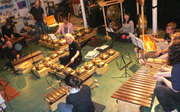Teach Me! Indonesian Gamelan
A taste of Indonesia, without leaving home
14th August 2013 / Blog “Big Travel Nut” Reprinted and Edited with Permission (Edited by Andrew Timar, Oct. 2, 2013)
I am sitting on a mat on the wooden floor, in my socks, facing a large xylophone-like instrument. In the windowless room, a dozen other people, ranging in age from 20 to 70, are also sitting, shoeless, in front of various percussion instruments that look like xylophones or metallic drums. Despite the fact that most of us have only rudimentary musical notions, we are about to create a masterpiece of Indonesian music, under the direction of veteran gamelan musicians Rick Sacks and Andrew Timar of the Evergreen Club Contemporary Gamelan.
Actually, I’m exaggerating a bit. A masterpiece we did not create, but the result may surprise you. So, how did this come about you may wonder, and what on earth is gamelan?
Gamelan refers to a kind of traditional Indonesian ensemble or orchestra originally from the islands of Java, Bali and surrounding islands. In addition to the instruments I mentioned already bowed and plucked strings as well as vocals are often featured. Gamelan also refers to the group of players and the repertoire they play. The set of instruments are built and tuned to stay together: instruments from different gamelan are generally not interchangeable. The Evergreen Club’s set is styled after the Sundanese gamelan degung specific to West Java, Indonesia.
Traditionally the wood cases and stands of a gamelan feature intricate carved and painted culture-specific details lending each set a unique character. The Evergreen Club’s members made their own stands out of clear Canadian maple in 1999. Its modernist design reflects both the group’s contemporary music making and its desire to serve as a bridge between the West Javanese cultural origin of the gamelan degung instruments and the Canadian culture of its players.
Illustrated on Javanese temple reliefs as early as the 8th century CE, some gamelan instruments reflect the Hindu-Buddhist era culture that long ago dominated parts of the modern nation of Indonesia. Today in its homeland gamelan music often accompanies stage and social dance performances, sophisticated puppet theatre and important public occasions requiring the ceremonial blessing of received ancestral traditions. Purely instrumental gamelan music, as well as singing in local languages accompanied by the gamelan comprises one part of the Indonesian regional music scene. It’s found on VCDs (a popular video/music medium), TV, radio, and on CDs and cassette titles.
The Evergreen Club has been active since 1983, playing concerts, recording and touring. When Rick and Andrew realized that the Evergreen Club’s instruments were sitting unused in boxes between performances, they decided to open up the crates once a month and invite the public to experience making music on them via Meetup.com. The original invite read:
Community Gamelan: Everyone Making Beautiful Music Together. Anyone can learn how to play just by sitting down at one of the instruments and playing! There are two facilitators to help with some basics but after that you are on a road to discovery and making new friends in the process.
Understandably many people doubted they could play music within a few hours, especially on such foreign looking instruments. But thanks to our teachers’ patience and simple instructions, we were up improvising in no time.
Here is a little video I put together to give you an idea of what the experience was like.
It was a fun way to spend a Saturday afternoon! Over a two-and-a-half hour period, we each got to play three different instruments, each time learning a simple sequence of notes (with perhaps a few variations) that we played repeatedly in guided improvisations. After a while our music became almost hypnotic.
Most of us used five notes of the degung scale although Andrew, who improvised the suling(bamboo ring flute), plays other notes as well, as you can hear in the audio clip. In addition you can also hear the string instrument called kacapi, a plucked zither looking like a shallow enameled box with 20 steel strings attached. The xylophone (gambang) and three of the metallophones (panerus; peking; slentem) have ranges spanning several octaves. The playing technique on most of the melodic percussion instruments consists of striking a gong or key then damping the vibration as you play the next note. This particular exercise in co-ordination is probably the most difficult part of the technique for beginners.
I really enjoyed gamelan music when I travelled in Indonesia back in 1995 and I’m glad to be re-introduced to it right here in my hometown of Toronto.


